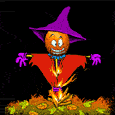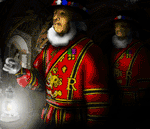In some ways Bonfire
Night is related to the ancient festival of Samhain, the Celtic New
Year. Bonfires formed an important part of the Celtic New Year
celebrations - warding off evil spirits. Bonfires play a part in many
customs all over the world. On November 5th as part of Bonfire Night
celebrations we too light bonfires. What makes the British Bonfire
Night celebrations special is the burning of the guy.
The tradition of Guy Fawkes-related bonfires actually began the very same year as the failed coup. The Plot was foiled in the night between the 4th and 5th of November 1605. Already on the 5th, agitated Londoners who knew little more than that their King had been saved, joyfully lit bonfires in thanksgiving. As years progressed, however, the ritual became more elaborate.
Soon, people began placing effigies onto bonfires, and fireworks were added to the celebrations. Effigies of Guy Fawkes, and sometimes those of the Pope, graced the pyres. Still today, some communities throw dummies of both Guy Fawkes and the Pope on the bonfire (and even those of a contemporary politician or two), although the gesture is seen by most as a quirky tradition, rather than an expression of hostility towards the Pope.
 To this day, one of
the ceremonies that accompany the opening of a new session of
parliament, is the searching of the basement, by a bunch of men in
funny hats. Parliament somehow made political capital out of the close
call, and poor Guido Fawkes is burned in effigy every November 5th on
bonfires all over Britain.
To this day, one of
the ceremonies that accompany the opening of a new session of
parliament, is the searching of the basement, by a bunch of men in
funny hats. Parliament somehow made political capital out of the close
call, and poor Guido Fawkes is burned in effigy every November 5th on
bonfires all over Britain.
They sell a lot of fireworks too, and children beg for money on the streets to buy them. The children usually exhibit the "guy" or dummy that will be put on the fire. "Penny for the guy, mister?" is a common refrain at this time of year.
Preparations for Bonfire Night celebrations include making a dummy of Guy Fawkes, which is called "the Guy". Some children even keep up an old tradition of walking in the streets, carrying "the Guy" they have just made, and beg passersby for "a penny for the Guy." The kids use the money to buy fireworks for the evening festivities.
On the night itself, Guy is placed on top of the bonfire, which is then set alight; and fireworks displays fill the sky. In the last 10 years however, with the pervasiveness of American television and culture in England, the custom of celebrating Halloween is in the ascendancy, and many children are now going for the double treat: candy on October 31, money for November 5.
The extent of the celebrations and the size of the bonfire varies from one community to the next. Lewes, in the South East of England, is famous for its Bonfire Night festivities and consistently attracts thousands of people each year to participate.
Bonfire Night is not only celebrated in Britain. The tradition crossed the oceans and established itself in the British colonies during the centuries. It was actively celebrated in New England as "Pope Day" as late as the 18th century. Today, November 5th bonfires still light up in far out places like Newfoundland in Canada, and some areas in New Zealand.